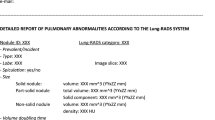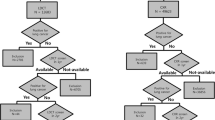Abstract
Purpose of Review
Lung cancer screening (LCS) using low-dose chest CT (LDCT) has been shown to decrease lung cancer specific morbidity and mortality (Jonas et al. in JAMA 325(10):971–87, 2021•). We aim to discuss important current and evolving concepts related to LCS, including major updates to the US Preventive Services Task Force (USPSTF) recommendations and to the lexicon used by radiologists in the reporting of LCS LDCT, the Lung Imaging Reporting and Data System (Lung-RADS).
Recent Findings
The number of individuals eligible to receive LCS has increased following the latest update to USPSTF recommendations, notably among women, minorities, and individuals of lower socioeconomic status (Ritzwoller et al. in JAMA Netw Open 4(10):e2128176, 2021). Since the inception of LCS programs, emerging evidence has allowed for updates to the Lung-RADS guidelines aimed at optimizing LCS efficiency and addressing various challenging clinical scenarios.
Summary
LCS has continually evolved since its debut. Updated guidelines aim at improving outcomes in the at-risk population. Nevertheless, continued efforts focused on increased LCS uptake are needed. Less than 6% of the eligible population is currently enrolled in a LCS program nationwide, while screening programs for breast and colon cancer have participation rates of 60–70% (New Report: Critically Low Lung Cancer Screening Rates Reveal Opportunity to Save More Lives. American Lung Association, 2022; Hall in Prev Chronic Dis 15, 2018).






Similar content being viewed by others
References
Papers of particular interest, published recently, have been highlighted as: • Of importance •• Of major importance
• Jonas DE, Reuland DS, Reddy SM, et al. Screening for lung cancer with low-dose computed tomography: updated evidence report and systematic review for the US Preventive Services Task Force. JAMA. 2021;325(10):971–87. Extensive review of data from major studies regarding benefits of lung cancer screening as well as challenges.
Ritzwoller DP, Meza R, Carroll NM, et al. Evaluation of population-level changes associated with the 2021 US Preventive Services Task Force lung cancer screening recommendations in community-based health care systems. JAMA Netw Open. 2021;4(10):e2128176–e2128176.
American Lung Association. New report: critically low lung cancer screening rates reveal opportunity to save more lives. 2022. Available at https://www.lung.org/media/press-releases/state-of-lung-cancer-2022. Accessed May 1, 2023.
Hall IJ. Patterns and trends in cancer screening in the United States. Prev Chronic Dis. 2018;15.
American College of Radiology Committee on Lung-RADS®. Lung-RADS assessment categories 2014. Available at https://www.acr.org/-/media/ACR/Files/RADS/Lung-RADS/LungRADS_AssessmentCategories.pdf. Accessed on May 1, 2023.
Chung K, Jacobs C, Scholten ET, et al. Lung-rads category 4X: does it improve prediction of malignancy in subsolid nodules? Radiology. 2017;284(1):264–71.
• Mendoza DP, Petranovic M, Som A, et al. Lung-rads category 3 and 4 nodules on lung cancer screening in clinical practice. Am J Roentgenol. 2022;219(1):55–65. Large study showing higher rates of malignancy in LungRADS 3 and 4 nodules with several imaging examples.
Martin MD, Kanne JP, Broderick LS, Kazerooni EA, Meyer CA. Lung-rads: pushing the limits. Radiographics. 2017;37(7):1975–93.
American College of Radiology Committee on Lung-RADS®. Lung-RADS assessment categories 2019. Available at https://www.acr.org/-/media/ACR/Files/RADS/Lung-RADS/LungRADSAssessmentCategoriesv1-1.pdf. Accessed on May 1, 2023.
•• American College of Radiology Committee on Lung-RADS®. Lung-RADS assessment categories 2022. Available at https://www.acr.org/-/media/ACR/Files/RADS/Lung-RADS/Lung-RADS-2022.pdf. Accessed on May 1, 2023. This is the official LungRADS 2.0 update from the American College of Radiology organized in table format with several footnotes for further information.
•• Kastner J, Hossain R, Jeudy J, et al. Lung-rads version 1. 0 versus Lung-rads version 1. 1: comparison of categories using nodules from the national lung screening trial. Radiology. 2021;300(1):199–206. Extensive study of nodules from the NLST using the 1.1 lexicon to show differences in screening results compared to LungRads 1.0. This study showed that the reclassification of perifissural nodules as benign in LungRADS 1.1 decreased false positive rates without significant false negative increase. They showed that this was not the case for groundglass nodules after ther LungRADS 1.1 update.
American College of Radiology Committee on Lung-RADS®. Lung-RADS v2022 summary of changes and updates. Available at https://www.acr.org/-/media/ACR/Files/RADS/Lung-RADS/Lung-RADS-2022-Summary-_Final.pdf. Accessed on May 1, 2023.
White CS, Dharaiya E, Dalal S, Chen R, Haramati LB. Vancouver risk calculator compared with acr lung-rads in predicting malignancy: analysis of the national lung screening trial. Radiology. 2019;291(1):205–11.
American College of Radiology Advocacy and Economics. ACR outlines specifics of new medicare lung cancer screening coverage. February 18, 2022. Available at https://www.acr.org/Advocacy-and-Economics/Advocacy-News/Advocacy-News-Issues/In-the-Feb-19-2022-Issue/ACR-Outlines-Specifics-of-New-Medicare-Lung-Cancer-Screening-Coverage. Accessed May 8, 2023.
• Cavers D, Nelson M, Rostron J, et al. Understanding patient barriers and facilitators to uptake of lung screening using low dose computed tomography: a mixed methods scoping review of the current literature. Respir Res. 2022;23(1):374. This article thoughtfully reviews several barriers to the uptake of LCS via an extensive literature review.
Reihani AR. Barriers and facilitators to lung cancer screening in the United States: a systematic review of the qualitative literature. J Heal Soc Sci. 2021;6:333–48.
Le T, Miller S, Berry E, Zamarripa S, Rodriguez A, Barkley B, et al. Implementation and uptake of rural lung cancer screening. J Am Coll Radiol. 2022;19(3):480–7.
Gomes R, Nederveld A, Glasgow RE, Studts JL, Holtrop JS. Lung cancer screening in rural primary care practices in Colorado: time for a more team-based approach? BMC Primary Care. 2023;24(1):62.
Special report on lung cancer and screening initiatives, part III. Imaging Technology News. 2023. Available at https://www.itnonline.com/article/special-report-lung-cancer-and-screening-initiatives-part-iii. Accessed on May 1, 2023.
Kim R, Rendle KA, Neslund-Dudas C, et al. Community-based lung cancer screening adherence to Lung-RADS recommendations. JCO. 2021;39(15_suppl):10540–10540.
• Barbosa EJM, Yang R, Hershman M. Real-world lung cancer CT screening performance, smoking behavior, and adherence to recommendations: lung-rads category and smoking status predict adherence. Am J Roentgenol. 2021;216(4):919–26. Retrospective single-center study of patients undergoing at least 2 LCS exams between 2014 and 2019 to characterize adherence and follow-up behaviors and longitudinal changes in smoking behavior.
•• American College of Radiology Committee on Lung-RADS®. Lung cancer screening CT incidental findings quick reference guide. 2022. Available at https://www.acr.org/-/media/ACR/Files/Lung-Cancer-Screening-Resources/LCS-Incidental-Findings-Quick-Guide.pdf. Accessed on May 1, 2023. Released with the most recent LungRADS 2.0 update, this Quick Reference Guide can be utilized by radiologists, referring providers, and LCS program coordinators to guide follow-up and management of incidental findings on LDCT for LCS.
Munden RF, Black WC, Hartman TE, et al. Managing incidental findings on thoracic CT: lung findings. A white paper of the ACR incidental findings committee. J Am Coll Radiol. 2021;18(9):1267–1279.
Munden RF, Carter BW, Chiles C, et al. Managing incidental findings on thoracic CT: mediastinal and cardiovascular findings. A white paper of the ACR incidental findings committee. J Am Coll Radiol. 2018;15(8):1087–1096.
Hoang JK, Langer JE, Middleton WD, et al. Managing incidental thyroid nodules detected on imaging: white paper of the ACR incidental thyroid findings committee. J Am Coll Radiol. 2015;12(2):143–50.
Chassagnon G, De Margerie-Mellon C, Vakalopoulou M, et al. Artificial intelligence in lung cancer: current applications and perspectives. Jpn J Radiol. 2023;41(3):235–44.
Gill RR. Virtual image-based biopsy of lung metastases: the promise of radiomics. Acad Radiol. 2023;30(1):47–8.
Binczyk F, Prazuch W, Bozek P, Polanska J. Radiomics and artificial intelligence in lung cancer screening. Transl Lung Cancer Res. 2021;10(2):1186–99.
Milanese G, Sabia F, Ledda RE, et al. Volumetric measurements in lung cancer screening reduces unnecessary low-dose computed tomography scans: results from a single-center prospective trial on 4119 subjects. Diagnostics (Basel). 2022;12(2):229.
Pastorino U, Silva M, Sestini S, et al. Prolonged lung cancer screening reduced 10-year mortality in the MILD trial: new confirmation of lung cancer screening efficacy. Ann Oncol. 2019;30(7):1162–9.
Fathi J, White S, Greenberg G. The integral role of the electronic health record and tracking software in the implementation of lung cancer screening—a call to action to developers: a white paper from the National Lung Cancer Roundtable. Chest. 2020;157(6):1674–9.
Author information
Authors and Affiliations
Corresponding author
Ethics declarations
Conflict of Interest
A Herring declares that she has no conflicts of interest. CS White declares he has no conflicts of interest. L Chelala declares that she has no conflicts of interest.
Human and Animal Rights and Informed Consent
This article does not contain any studies with human or animal subjects performed by any of the authors.
Additional information
Publisher's Note
Springer Nature remains neutral with regard to jurisdictional claims in published maps and institutional affiliations.
Rights and permissions
Springer Nature or its licensor (e.g. a society or other partner) holds exclusive rights to this article under a publishing agreement with the author(s) or other rightsholder(s); author self-archiving of the accepted manuscript version of this article is solely governed by the terms of such publishing agreement and applicable law.
About this article
Cite this article
Herring, A., Chelala, L. & White, C.S. Lung RADS: Lessons Learned and Strategies for the Optimization of Lung Cancer Screening. Curr Pulmonol Rep 12, 181–189 (2023). https://doi.org/10.1007/s13665-023-00325-w
Accepted:
Published:
Issue Date:
DOI: https://doi.org/10.1007/s13665-023-00325-w




